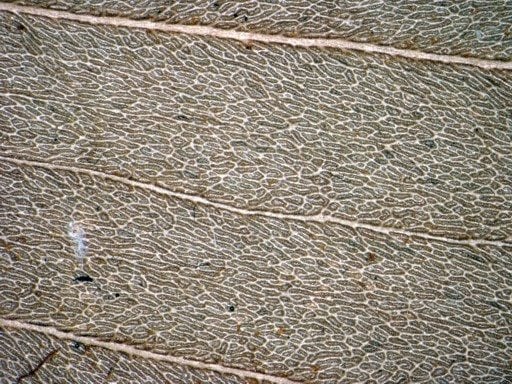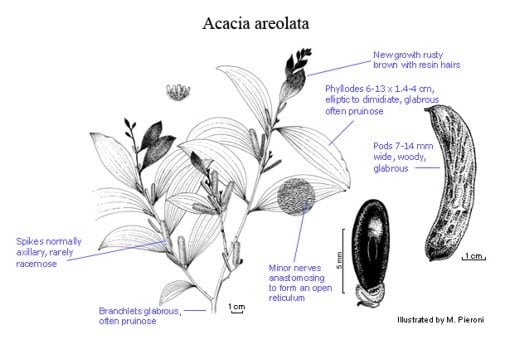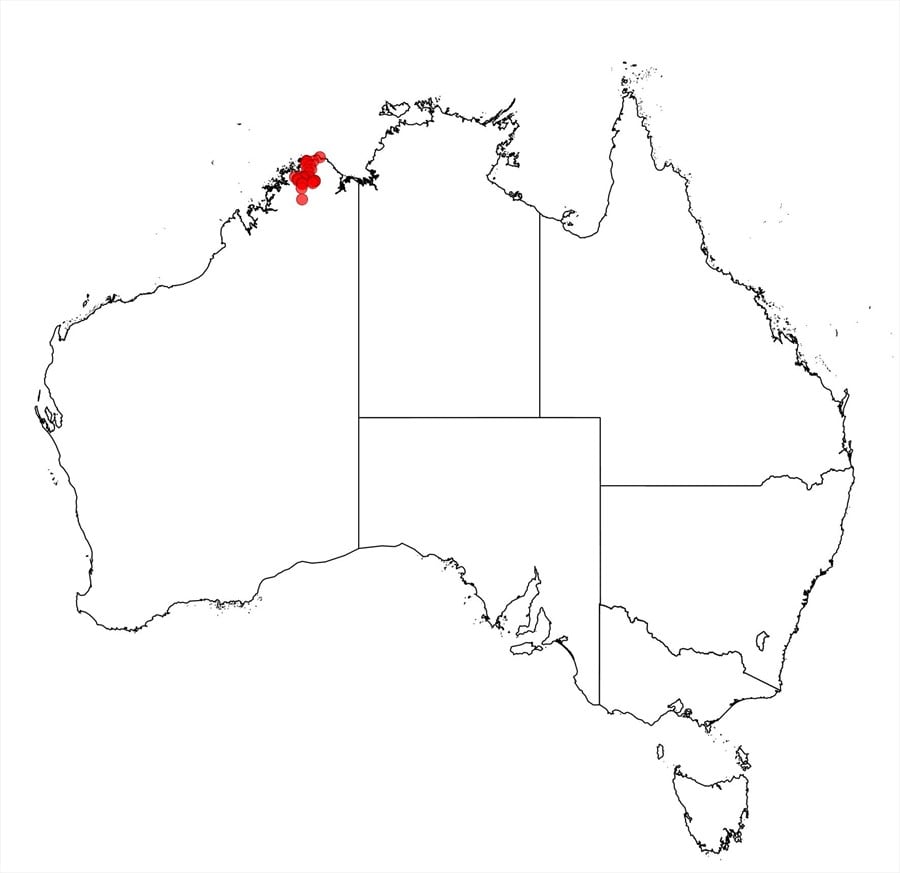Acacia areolata M.W.McDonald
WATTLE
Acacias of Australia
Family
Fabaceae
Distribution
Endemic to the northern Kimberley region, extending from Cape Londonderry S to the Carson Escarpment, W.A.
Description
Spreading shrub commonly 2–4 m tall, occasionally tree to 8 m, rarely prostrate. Bark fissured, grey-brown. New shoots resinous, rusty-brown, glabrous. Branchlets slightly flattened at extremities becoming terete, glabrous, grey or reddish, often pruinose. Phyllodes commonly straight and dimidiately elliptic to narrowly elliptic or ovate-elliptic but sometimes slightly subfalcately recurved, infrequently straight and symmetrically broad-elliptic, 6–12 (–16) cm long, (14–) 20–40 (–50) mm wide, glabrous, green or pruinose, with 3–5 prominent longitudinal veins, the minor veins numerously anastomosing to form a distinct, net-like reticulum comprising ±oblong to narrowly oblong (rarely isodiametric), longitudinal nerve-islands; gland basal, obscure. Inflorescences 1–2 (–3) per axil, simple or occasionally a few short-racemose; peduncles glabrous, scurfy, spikes 2–4.5 cm long, flowers densely arranged, yellow. Flowers 5-merous; calyx deeply lobed, villous; ovary pubescent. Pods narrowly oblong to oblong, straight, 2.5–7.5 cm long, 9–15 mm wide, ±flat, longitudinally furrowed when dry, glabrous, often pruinose. Seeds transverse to oblique, broadly elliptic, laterally compressed, 6–7 mm long, black; pleurogram lateral, with indistinct halo; areole oblong-elliptic, open.
Phenology
Flowers mainly in June.
Habitat
Grows in open woodlands mainly on laterite and sandstone substrates.
Specimens
W.A.: 24 km S of Mitchell Plateau turn-off, B.Barnsley 1561 (NSW, PERTH); Euro Gorge, Drysdale R. Natl Park, K.F.Kenneally 4383 (BRI, PERTH); 5.1 km W along Mitchell Plateau Rd, M.McDonald 329 (PERTH); 8.9 km NE of Pago near Kalumburu, M.McDonald 1887 (BRI, PERTH).
Notes
This taxon was treated as A. aff. retinervis by M.W.McDonald in B.R.Maslin (coordinator), WATTLE Acacias of Australia CD-ROM (2001), and noted under A. retinervis as a variant of uncertain rank by M.W.McDonald & P.G.Kodela, Fl. Austral. 11B: 189 (2001).
Acacia areolata is a member of the ‘A. tumida group’ that is closely related to, and commonly confused with, the parapatric A. retinervis which is distinguished in the following ways: pods sub-terete to compressed and narrower (6–8 mm wide), branchlets never pruinose, mature phyllodes falcate to subfalcate (seemingly dimidiate only on juvenile plants), generally narrower (mostly 8–20 mm wide) and with normally less prominent anastomosing minor nerves that form narrower, more clearly elongated, but normally less well-circumscribed nerve-islands (phyllodes rarely developing a net-like reticulum that characterizes A. areolata).
FOA Reference
Data derived from Flora of Australia Volumes 11A (2001), 11B (2001) and 12 (1998), products of ABRS, ©Commonwealth of Australia
Author
B.R.Maslin, M.W.McDonald
This identification key and fact sheets are available as a mobile application:
URL: https://apps.lucidcentral.org/wattle/
© Copyright 2018. All rights reserved.








